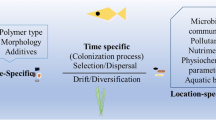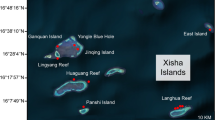Abstract
Purpose
Mining is a common source of metals in aquatic ecosystems. Metal loading in the environment is thought to be a selective pressure that induces compositional and functional changes within the affected microbial community in the sediment. This study aims to explore shifts in the diversity, structure, and functional gene abundance of microbial communities in the sediment of the copper mining-induced contaminated lakes in Finland.
Materials and methods
The sediment microbial community structures and abundance of the functional groups involved in carbon/nitrogen/sulfur cycling in four lakes located downstream from metal mines (Kirkkoselkä (KS), Junttiselkä (JS), Laakajärvi (LJ), and Sysmäjärvi (SJ)) and one reference lake (Parkkimanjärvi (PJ)) in Finland were compared using high throughput sequencing and quantitative PCR.
Results and discussion
Compared to the PJ reference lake sediment, the relative abundances were higher for Bacteroidetes, Gemmatimonadetes, Acidobacteria, and Nitrospirae but lower for Firmicutes and Alphaproteobacteria in the mine-contaminated sediment samples. The number of copies of copper-resistant genes (copA) in the two copper-contaminated sediments (5.34 × 106 and 4.95 × 106 copies ng−1 DNA for KS and JS, respectively) was significantly higher than that in the PJ sediment (1.33 × 106 copies ng−1 DNA). Methanogens (mcrA gene) accounted for 5.09–11.5% of the total archaea (16S rRNA) in these lake sediments. In addition, ammonia-oxidizing archaea (amoA gene) in the LJ sediment accounted for 36.0% of the total archaea but only 0.83–1.63% in the sediment of other lakes. The abundance of eight investigated functional groups accounted for 28.8% of the total bacteria in the PJ sediment but less than 1.3% in the metal-contaminated sediments. The canonical correspondence analysis showed that the microbial community structure of Lake LJ was scattered far from the other lakes and was significantly correlated with nitrate; the community structural change in the JS and KS sediments was positively correlated with copper or negatively correlated with nitrate concentration.
Conclusions
These results indicate that the sedimentary indigenous microbial community may shift its composition and structure as well as its function to increase its adaptability and/or resistance to metal-contaminated freshwater sediments.






Similar content being viewed by others
References
Altimira F, Yáñez C, Bravo G, González M, Rojas LA, Seeger M (2012) Characterization of copper-resistant bacteria and bacterial communities from copper-polluted agricultural soils of central Chile. BMC Microbiol 12(1):193
Caporaso JG, Kuczynski J, Stombaugh J, Bittinger K, Bushman FD, Costello EK, Fierer N, Peña AG, Goodrich JK, Gordon JI, Huttley GA, Kelley ST, Knights D, Koenig JE, Ley RE, Lozupone CA, McDonald D, Muegge BD, Pirrung M, Reeder J, Sevinsky JR, Turnbaugh PJ, Walters WA, Widmann J, Yatsunenko T, Zaneveld J, Knight R (2010) QIIME allows analysis of high-throughput community sequencing data. Nat Methods 7:335–336
Cole JR, Chai B, Farris RJ, Wang Q, Kulam-Syed-Mohideen AS, McGarrell DM, Bandela AM, Cardenas E, Garrity GM, Tiedje JM (2007) The ribosomal database project (RDP-II): introducing my RDP space and quality controlled public data. Nucleic Acids Res 35:169–172
Edgar RC (2010) Search and clustering orders of magnitude faster than BLAST. Bioinformatics 26(19):2460–2461
Eggleton J, Thomas KV (2004) A review of factors affecting the release and bioavailability of contaminants during sediment disturbance events. Environ Int 30:973–980
Feinstein LM, Sul WJ, Blackwood CB (2009) Assessment of bias associated with incomplete extraction of microbial DNA from soil. Appl Environ Microbiol 75(16):5428–5433
Gillan DC, Danis B, Pernet P, Joly G, Dubois P (2005) Structure of sediment-associated microbial communities along a heavy-metal contamination gradient in the marine environment. Appl Environ Microbiol 71(2):679–690
Gillan DC, Pernet P (2007) Adherent bacteria in heavy metal contaminated marine sediments. Biofouling 23:1e13
Giusti L (2001) Heavy metal contamination of brown seaweed and sediments from the UK coastline between the Wear River and the Tees River. Environ Int 26:275–286
González AG, Shirokova LS, Pokrovsky OS, Emnovad EE, Martíneze RE, Santana-Casianoa JM, González-Dávilaa M, Pokrovskib GS (2010) Adsorption of copper on Pseudomonas aureofaciens: protective role of surface exopolysaccharides. J Colloid Interface Sci 350(1):305–314
Gough HL, Stahl DA (2011) Microbial community structures in anoxic freshwater lake sediment along a metal contamination gradient. ISME J 5(3):543–558
He LY, Zhang YF, Ma HY, Su LN, Chen ZJ, Wang QY, Qian M, Sheng XF (2010) Characterization of copper-resistant bacteria and assessment of bacterial communities in rhizosphere soils of copper-tolerant plants. Appl Soil Ecol 44(1):49–55
Hoostal MJ, Bidart-Bouzat MG, Bouzat JL (2008) Local adaptation of microbial communities to heavy metal stress in polluted sediments of Lake Erie. FEMS Microbiol Ecol 65(1):156–168
Jose J, Giridhar R, Anas A, Loka Bharathi PA, Nair S (2011) Heavy metal pollution exerts reduction/adaptation in the diversity and enzyme expression profile of heterotrophic bacteria in Cochin estuary, India. Environ Pollut 159:2775e2780
Kang S, Nostrand JDV, Gough HL, He Z, Hazen TC, Stahl DA, Zhou J (2013) Functional gene array-based analysis of microbial communities in heavy metals-contaminated lake sediments. FEMS Microbiol Ecol 86(2):200
Li XF, Zhu YG, Cavagnaro TR, Chen MM, Sun JW, Chen XP, Qiao M (2009) Do ammonia-oxidizing archaea respond to soil Cu contamination similarly as ammonia-oxidizing bacteria? Plant Soil 324(1–2):209–217
Li X, Zhu YG, Shaban B, Bruxner TJC, Bond PL, Huang LB (2015) Assessing the genetic diversity of Cu resistance in mine tailings through high-throughput recovery of full-length copA genes. Sci Rep 5:13258. doi:10.1038/srep13258
Lors C, Tiffreau C, Laboudigue A (2004) Effects of bacterial activities on the release of heavy metals from contaminated dredged sediments. Chemosphere 56:619–630
Mackintosh TJ, Davis JA, Thompson RM (2016) Impacts of multiple stressors on ecosystem function: leaf decomposition in constructed urban wetlands. Environ Pollut 208:221–232
Mäkinen J, Lerssi J (2007) Characteristics and seasonal variation of sediments in Lake Junttiselkä, Pyhäsalmi, Finland. Mine Water Environ 26(4):217–228
Nealson KH (1997) Sediment bacteria: who’s there, what are they doing, and what’s new? Annu Rev Earth Planet Sci 25:403–434
Ni C, Horton DJ, Rui J, Henson MW, Jiang Y, Huang X, Learman DR (2016) High concentrations of bioavailable heavy metals impact freshwater sediment microbial communities. Ann Microbiol 66(3):1003–1012
Oksanen J, Blanchet G, Kindt R, Legendre P, O’Hara RG, Simpson GL (2010) Vegan: community ecology package. R Package Version 1:17–11
Quast C, Pruesse E, Yilmaz P, Gerken J, Schweer T, Yarza P, Peplies J, Glöckner FO (2012) The SILVA ribosomal RNA gene database project: improved data processing and web-based tools. Nucleic Acids Res 41:D590–D596
Ryan RP, Ryan DJ, Dowling DN (2005) Multiple metal resistant transferable phenotypes in bacteria as indicators of soil contamination with heavy metals. J Soils Sediments 5:95–100
Sauvain L, Bueche M, Junier T, Masson M, Wunderlin T, Kohler-Milleret R, Diez EG, Loizeau J, Tercier-Waeber M, Junier P (2014) Bacterial communities in trace metal contaminated lake sediments are dominated by endospore-forming bacteria. Aqua Sci 76(1):33–46
Sun FL, Fan LL, Xie GJ (2016) Effect of copper on the performance and bacterial communities of activated sludge using Illumina MiSeq platforms. Chemosphere 156:212–219
Utgikar VP, Tabak HH, Haines JR, Govind R (2003) Quantification of toxic and inhibitory impact of copper and zinc on mixed cultures of sulfate-reducing bacteria. Biotech Bioengin 82(3):306–312
Väänänen K, Kauppila T, Mäkinen J, Leppänen MT, Lyytikäinen M, Akkanen J (2016) Ecological risk assessment of boreal sediments affected by metal mining: metal geochemistry, seasonality, and comparison of several risk assessment methods. Integr Environ Assess Manag 12(4):759–771
Vignesh S, Dahms HU, Emmanuel KV, Gokul MS, Muthukumar K, Kim BR, James RA (2014) Physicochemical parameters aid microbial community? A case study from marine recreational beaches, Southern India. Environ Monit Assess 186:1875–1887
Volodina LA, Zhigach AN, Leĭpunskiĭ IO, Fedorov II (2009) Mechanism of the toxic action of copper nanoparticles on Escherichia coli bacteria. Biofizika 54(6):1060
Wieland F, Hartert C (1999) Mechanisms of vesicle formation: insights from the COP system. Curr Opin Cell Biol 11(4):440–446
Xie Y, Wang J, Wu Y, Ren C, Song C, Yang J, Zhang X (2016) Using in situ bacterial communities to monitor contaminants in river sediments. Environ Pollut 212:348–357
Yin H, Niu J, Ren Y, Cong J, Zhang X, Fan FL, Xia Y, Zhang X, Deng J, Xie M, He Z, Zhou J, Liang Y, Liu X (2015) An integrated insight into the response of sedimentary microbial communities to heavy metal contamination. Sci Rep 5(1):14266. doi:10.1038/srep14266
Yu C, He X, Zhang C, Li C, Liu J (2015) Treatment of iron and copper in wastewater by immobilized sulfate reducing bacteria and producing H2S by an indirect method. FOG - Freiberg Online Geosci 40:109–115
Zhang X, Gu Q, Long XE, Li ZL, Liu DX, Ye DH, He CQ, Liu XY, Väänänen K, Chen XP (2016) Anthropogenic activities drive the microbial community and its function in urban river sediment. J Soils Sediments 16(2):716–725
Mato Rodriguez L, Alatossava T (2010) Effects of copper on germination, growth and sporulation of Clostridium tyrobutyricum. Food Microbiology 27(3):434–437
Acknowledgements
This research was supported by the National Key Research and Development Project by Most of China (2016YFA0601000), the National Natural Science Foundation of China (41373097, 31300443 41101230), the Shanghai Science and Technology Committee (12231202004), the Shanghai Key Laboratory of Bio-Energy Crops (10DZ2271800), and the Kone Foundation (Finland).
Author information
Authors and Affiliations
Corresponding authors
Additional information
Responsible editor: Martin Romantschuk
Rights and permissions
About this article
Cite this article
Chen, XP., Chen, HY., Sun, J. et al. Shifts in the structure and function of the microbial community in response to metal pollution of fresh water sediments in Finland. J Soils Sediments 18, 3324–3333 (2018). https://doi.org/10.1007/s11368-017-1782-5
Received:
Accepted:
Published:
Issue Date:
DOI: https://doi.org/10.1007/s11368-017-1782-5




